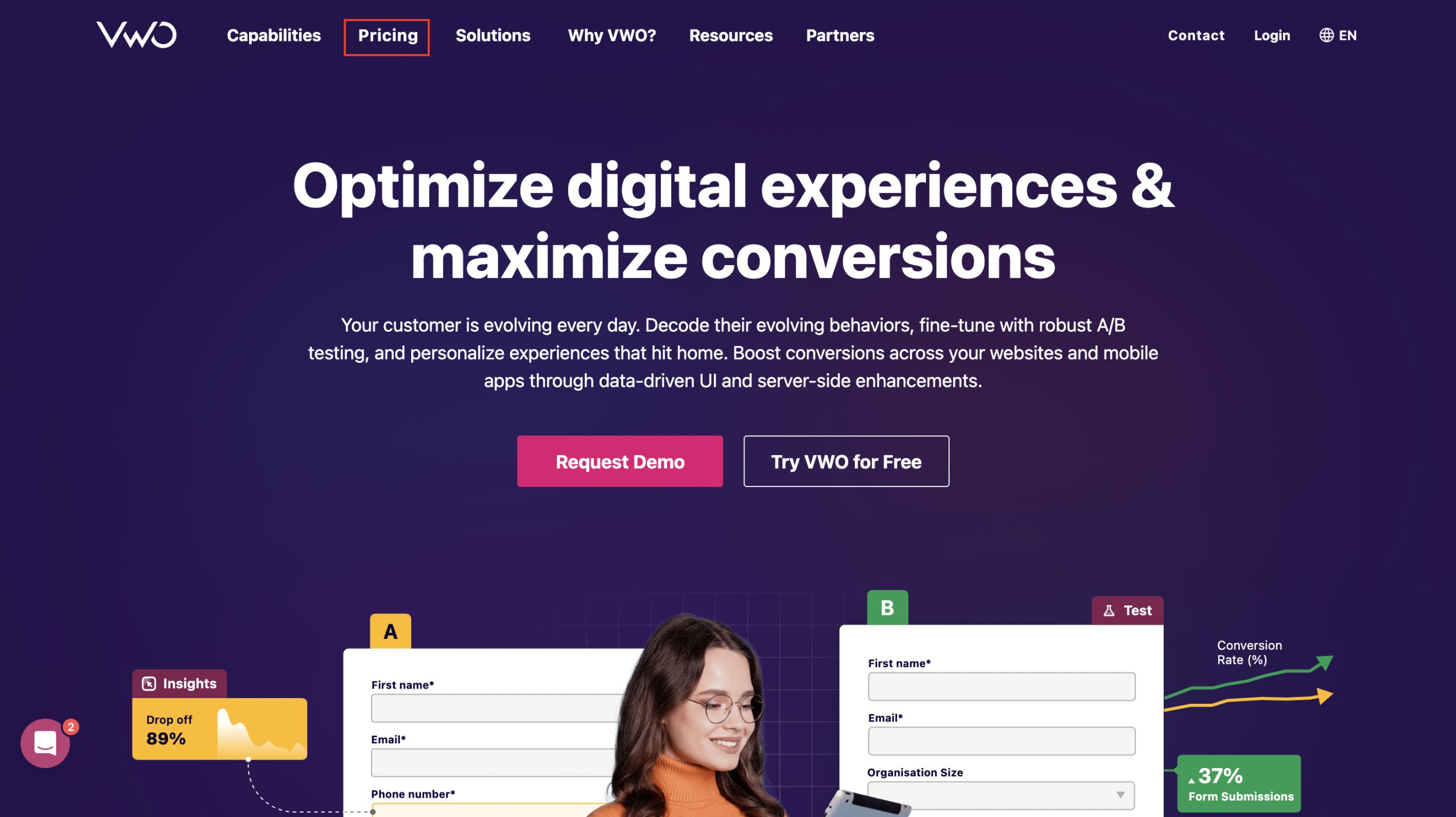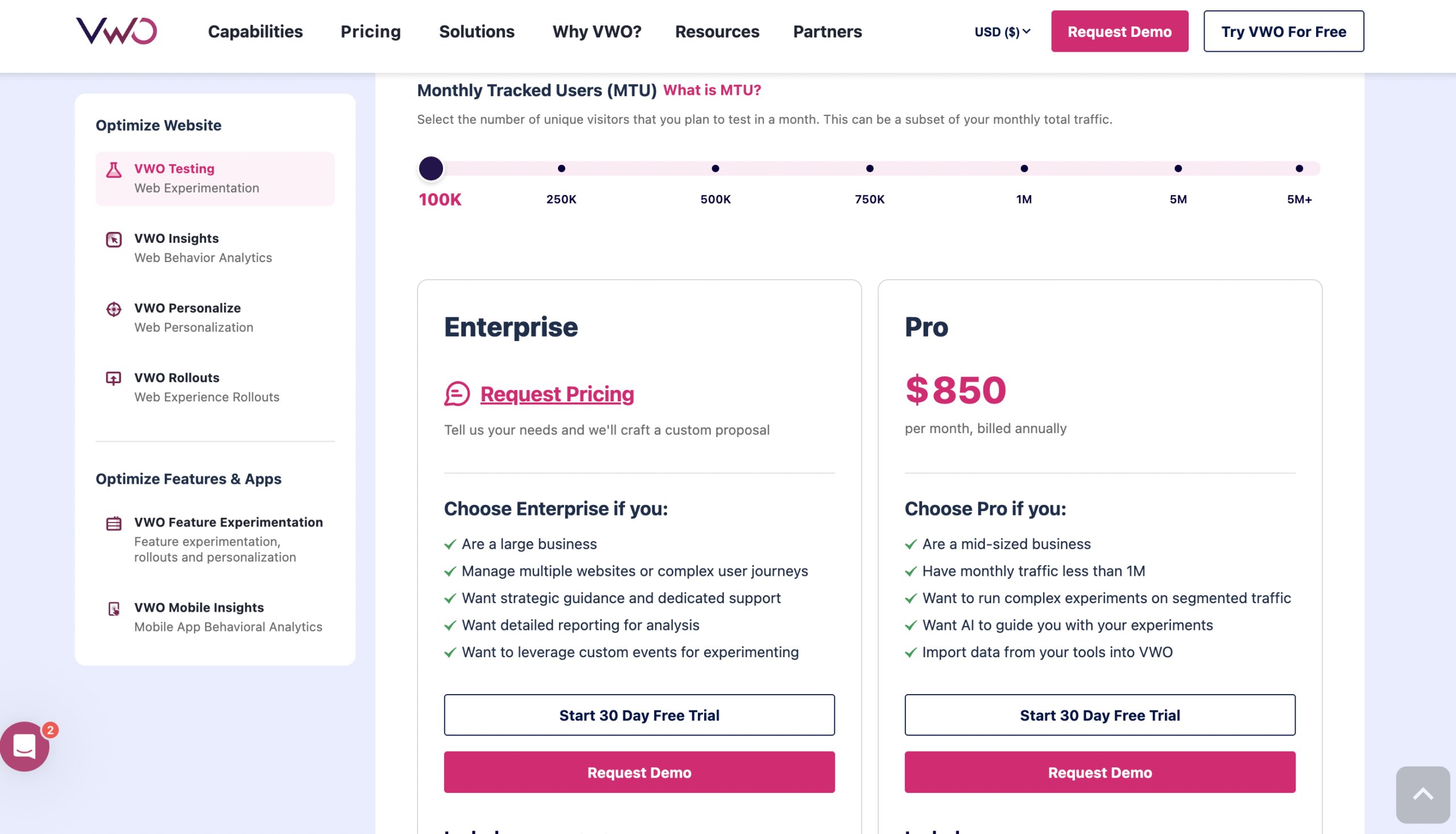What is conversion?
In digital marketing, a conversion is a desired action you want visitors to take, such as clicking a call-to-action, clicking an ad, signing up, or making a purchase.
Conversions are categorized into micro and macro conversions. Micro-conversions are small steps, like clicking a link or adding an item to the cart. Macro-conversions are more aligned with business goals, such as completing a purchase or subscribing to a paid plan.
Real-life example of micro and macro-conversion
Take VWO’s website as an example. A micro-conversion would be clicking the “Pricing” CTA at the top of the page.

On the pricing page, macro-conversions occur when visitors click “Request Demo” or “Start 30-Day Free Trial.”

How to calculate the conversion?
Conversion is calculated as the conversion rate. It measures the effectiveness of a digital touchpoint. It’s calculated with this formula:
Conversion rate = (Number of conversions (e.g., purchase) / Total visitors) x 100
This metric helps evaluate performance and compare it against industry benchmarks to determine if your conversion rate is strong or needs improvement.
How to track conversion?
Tracking conversions is essential for any digital marketing campaign. Here’s how to start:
- Define visitor activity: Identify the specific actions you consider conversions. This could be anything from scrolling a certain depth on a page to making a purchase. Organize these actions into stages within the customer journey.
- Categorize conversions: Once you’ve defined conversions, divide them into micro and macro conversions.
- Select your tracking tool: Choose a tool based on your needs. You can start with a quantitative tracking tool like GA4 to monitor basic metrics. If you need more detailed insights into user behaviour, consider adding a behaviour analysis tool that tracks how visitors interact with specific elements on your site. You can also use native tracking for platforms like Google Ads or Meta to capture conversion data of paid ads.
- Set up tracking: To begin tracking, place the necessary tracking code (e.g., Google Analytics, Facebook Pixel) on your website or app. This allows the tool to collect data and give you insights into visitor actions.
- Monitor and analyze: After setting up, continuously monitor conversions and identify any drop-off points, where visitors leave before completing a desired action. Analyzing this data will help you spot issues and improve user experience to increase conversions
Tips to improve conversion
Conversion is key to business success because it directly impacts profit. If your conversions are low, here are several strategies to improve them:
- Behavior analytics: Use tools like heatmaps, session recordings, and surveys to identify where visitors are struggling. Develop hypotheses about improving the user experience and increasing conversions.
- Experimentation: Run experiments like A/B tests to compare new experiences with the old ones. This helps determine what changes lead to better conversions.
- Personalization: Use visitor data such as location, age, gender, or interests (e.g., coupon usage) to tailor experiences. Personalised content engages visitors and improves conversions.
- Interviews: Conduct user interviews to uncover pain points and reasons for drop-offs. Use their feedback to fine-tune the experience and improve conversion.
- UI/UX revamp: Overhaul the user interface and experience to remove friction points. A smoother, more intuitive design can lead to higher conversion.
- Landing pages: Create specific landing pages for your campaigns. This reduces information overload and makes it easier for visitors to take action and convert.
Improving conversion with VWO
VWO is a comprehensive experience optimization platform that helps improve conversions through its diverse capabilities. Here’s how:
- VWO Insights: Understand visitor behavior with heatmaps, session recordings, form analytics, funnel analysis, and on-page surveys across mobile, app, and website.
- VWO Testing: Run experiments like A/B tests to compare changes with the original experience on mobile, app, and website.
- VWO Personalize: Tailor experiences based on visitor data like location, age, and gender on your website.
- VWO Feature Experimentation: Run complex server-side experiments to optimize your entire digital infrastructure.
How VWO helped a 140+ year-old bank improve conversions:
IMB Bank faced challenges with conversions on its loan page. Using VWO Insights, they discovered visitors were abandoning the form before completing it. To address this, they introduced a pop-up when the user’s mouse was about to leave the screen. They A/B tested this addition with VWO, and the result was an 87% increase in conversions.
VWO helped IMB Bank identify issues and improve conversions. You can read more about IMB Bank’s success story.
If you want to know how VWO can help boost your conversions, too? You can sign up for a quick demo today.










